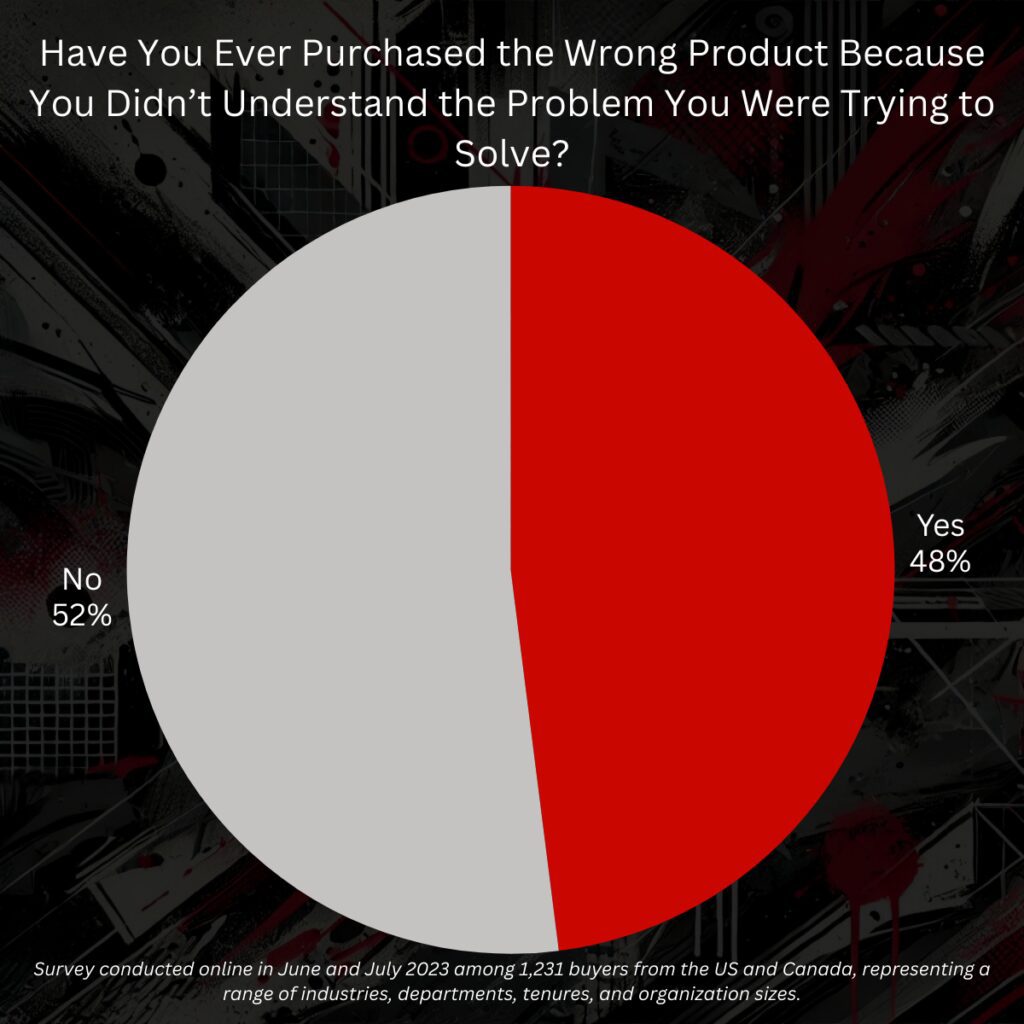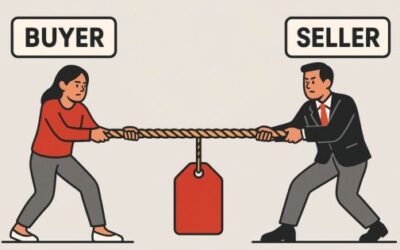Half of all B2B purchases fail to solve the intended business problem. This widespread issue stems from a critical gap – buyers often don’t fully grasp the problem they’re trying to address, leading them to invest in ill-fitting solutions. These organizations are investing resources on ineffective products while their core business challenges persist unresolved.
This misalignment triggers a chain reaction that affects both the buyer and the seller. Buyers continue to struggle while sellers see their churn rates start to creep up and customer satisfaction scores start to drop. All caused by a pervasive sales culture that continues to prioritize quota attainment over problem-solving.
B2B Purchasing Misalignment
To better understand the reason why B2B sales seem to be falling, ASG conducted a comprehensive survey of over 1,200 B2B buyers across the United States and Canada. The respondents included C-Level Executives, Senior Executives, Directors, and Managers from various function groups.
Executives, Senior Executives, Directors, and Managers from various function groups.
The survey shows that 48% of buyers reported purchasing the wrong product due to an incomplete understanding of the business problem they initially sought out to solve. This misalign leads to several immediate and significant consequences for buyers:
- Resources allocated to purchases of ineffective solutions are for all intents and purposes wasted.
- Selecting, implementing, and attempting to use this ineffective solution consumes valuable time that could have been spent addressing the issue.
- The original problems remain unsolved continuing to impact operations
- Negative experiences with ineffective purchases can lead to hesitation in future decision-making, slowing necessary improvements
The root cause of these misaligned purchases lies in a fundamental misunderstanding of the problem at hand. When buyers don’t or can’t fully grasp the nature and scope of the business problem they’re ill-equipped to evaluate a potential solution properly.
Seller’s Cost of Misalignment
From the seller’s perspective, the “sell at all costs” mentality that leads to this misalignment exposes organizations to several significant risks:
Increasing churn rates – when buyers realize a product doesn’t solve their problem they’re very likely to churn, leading to lost recurring revenue and increased customer acquisition costs
Reputational Damage – it’s never been easier for dissatisfied customer to impact a company’s reputation with online reviews and social media
Decreased efficiency – teams are wasting time chasing leads that are fundamentally misaligned, reducing efficiency, productivity, and effectiveness
The full study indicates that these issues stem from a basic misalignment between how buyers want to be sold to and current sales practices. Buyers are looking for direction and support in solving problems. They seek collaborative partners who can help them grasp the size and scope of the problem. They want help, not to be sold to.
However, many sales organizations are still primarily focused on pushing products and continue to qualify leads on outdated criteria like B.A.N.T. (Budget, Authority, Need, Timing). This approach exacerbates already challenging market conditions as organizations shrink budgets and apply more scrutiny to buying decision.
Pressure for Quota Attainment
Our analysis suggests the misalignment stems from the intense pressure for quota attainment. While intended to drive performance, this pressure often leads to counterproductive behaviors and outcomes.
- Short-term focus: Sellers, in their effort to meet quarterly or annual quotas, prioritize short-term wins over long-term customer success. This mentality results in product pushing to customers who may not be the best fit for the solution
- Product-centric approaches: Similarly, sellers focus on the features and benefits of their product rather than spending time in discovery uncovering and understanding the problems the customer is facing. This is precisely the opposite of what buyers want according to the research.
- Superficial qualification: In an effort to maximize limited time, sellers continue to rely on insufficient qualification methods such as B.A.N.T. which fail to capture the complexity of the buyer’s situation.
- Lack of business acumen: The pressure to sell leaves little time for salespeople to develop the business knowledge necessary for engaging in meaningful conversations with buyers. As a result, they struggle to provide insights and guidance.
- Resistance to Disqualification: Because of the push for quota, salespeople are reluctant to disqualify opportunities, regardless of fit, leading to wasted time and inflated pipeline expectations.
Buyers are seeking salespeople who can help them diagnose and understand their problems and be a guide towards a solution. Instead, they encounter salespeople who have a quota hanging above their head and whether intentional or not are focused on themselves and their quota rather than the customer’s problems.
Selling to Problem-Solving
To address this misalignment between sales practices and buyer wants, sales organizations must shift their approach. This transformation should focus on problem understanding through these strategies:
Prioritize Discovery. Allocate more time and resources to the discovery phase. Salespeople should be trained to conduct in-depth discoveries that uncovers the nature and scope of the challenges the buyer faces.
Invest in developing and enhancing the salesperson’s understanding of various industries and business functions that align with your ICP.
Implement Problem-Centric Qualification. Include criteria that assess the nature and urgency of the buyer’s problems, the impact of solving it, and most importantly, if you can solve the problem effectively.
Not all sales are good sales
A common theme from our research, not all sales are good sales. The fact that 47% of buyers report purchasing the wrong product due to a misunderstanding of their problem indicates a significant failure on the part of sales professionals to serve their clients effectively.
Misaligned sales lead to customer dissatisfaction and increased churn, increasing CAC costs, increased support and customer success costs, and damage to company reputation.
To combat this, sales teams should shift to problem-centric sales approaches. Help buyers define and scope their business problems, provide insights and guidance rather than product information, and act as a collaborative partner to find the right solution.
Companies that do so will build stronger, longer-lasting relationships with better solution fits, high satisfaction from customers, and distinguish themselves in crowded markets.



0 Comments